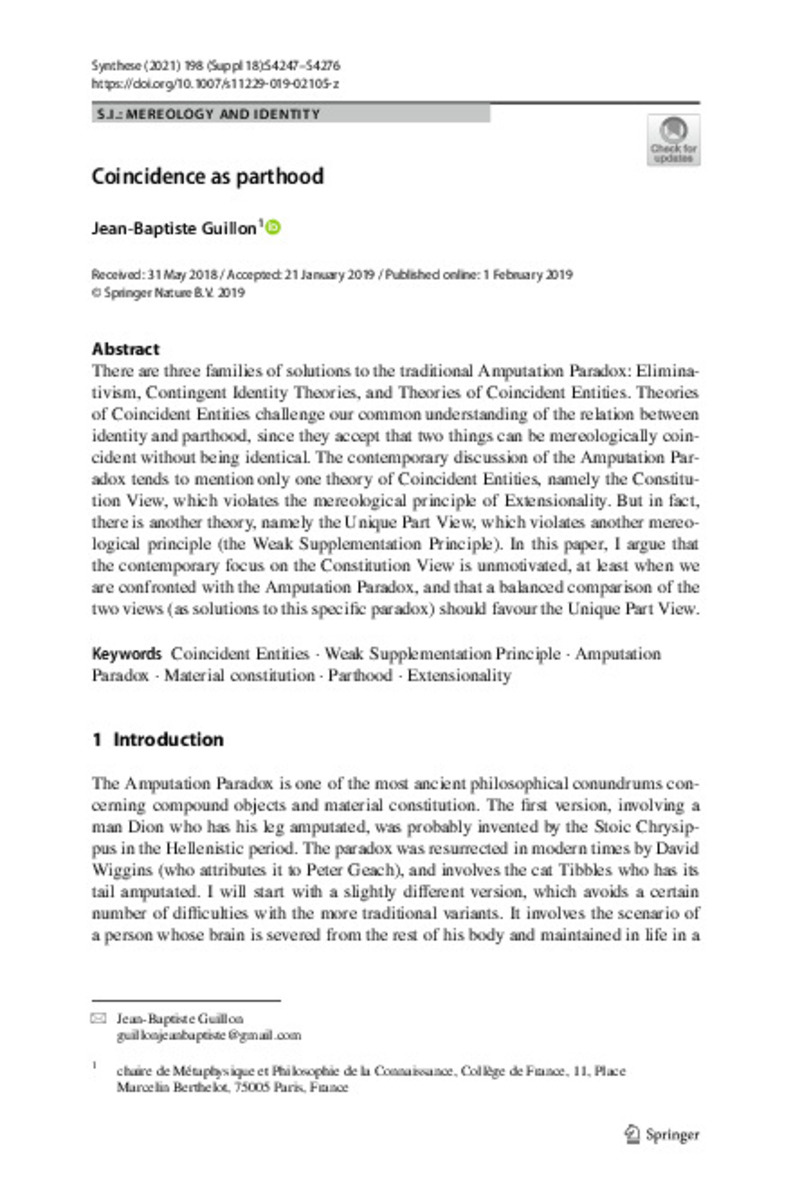Full metadata record
| DC Field | Value | Language |
|---|---|---|
| dc.creator | Guillon, J.B. (Jean-Baptiste) | - |
| dc.date.accessioned | 2024-01-16T11:40:54Z | - |
| dc.date.available | 2024-01-16T11:40:54Z | - |
| dc.date.issued | 2021 | - |
| dc.identifier.citation | Guillon, J.B. (Jean-Baptiste). "Coincidence as parthood". Synthese. 198, 2021, 4247 - 4276 | es_ES |
| dc.identifier.uri | https://hdl.handle.net/10171/68368 | - |
| dc.description.abstract | There are three families of solutions to the traditional Amputation Paradox: Eliminativism, Contingent Identity Theories, and Theories of Coincident Entities. Theories of Coincident Entities challenge our common understanding of the relation between identity and parthood, since they accept that two things can be mereologically coincident without being identical. The contemporary discussion of the Amputation Paradox tends to mention only one theory of Coincident Entities, namely the Constitution View, which violates the mereological principle of Extensionality. But in fact, there is another theory, namely the Unique Part View, which violates another mereological principle (the Weak Supplementation Principle). In this paper, I argue that the contemporary focus on the Constitution View is unmotivated, at least when we are confronted with the Amputation Paradox, and that a balanced comparison of the two views (as solutions to this specific paradox) should favour the Unique Part View. | es_ES |
| dc.language.iso | eng | es_ES |
| dc.rights | info:eu-repo/semantics/openAccess | es_ES |
| dc.subject | Coincident Entities | es_ES |
| dc.subject | Weak Supplementation Principle | es_ES |
| dc.subject | Amputation Paradox | es_ES |
| dc.subject | Material constitution | es_ES |
| dc.subject | Parthood | es_ES |
| dc.subject | Extensionality | es_ES |
| dc.title | Coincidence as parthood | es_ES |
| dc.type | info:eu-repo/semantics/article | es_ES |
| dadun.citation.endingPage | 4276 | es_ES |
| dadun.citation.publicationName | Synthese | es_ES |
| dadun.citation.startingPage | 4247 | es_ES |
| dadun.citation.volume | 198 | es_ES |
Files in This Item:
Statistics and impact
Items in Dadun are protected by copyright, with all rights reserved, unless otherwise indicated.






